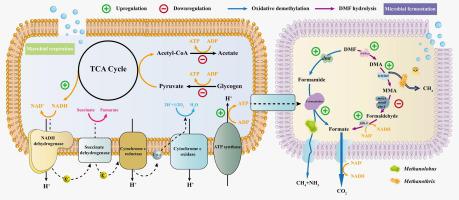当前位置:
X-MOL 学术
›
Chem. Eng. J.
›
论文详情
Our official English website, www.x-mol.net, welcomes your
feedback! (Note: you will need to create a separate account there.)
Identification of key microbial communities and intracellular metabolic pathways to response micro-aerobic environment for enhancing degradation of N, N-dimethylformamide in refractory membrane-making wastewater
Chemical Engineering Journal ( IF 13.3 ) Pub Date : 2023-12-20 , DOI: 10.1016/j.cej.2023.148179 Guang Yang , Yudong Luo , Xi Chen , Siyu Hu , Guangqing Song , Xia Huang
Chemical Engineering Journal ( IF 13.3 ) Pub Date : 2023-12-20 , DOI: 10.1016/j.cej.2023.148179 Guang Yang , Yudong Luo , Xi Chen , Siyu Hu , Guangqing Song , Xia Huang

|
Enhanced sludge hydrolysis in micro-aerobic environment with dissolved oxygen (DO) regulation could degrade stubborn refractory N, N -dimethylformamide (DMF) in membrane-making wastewater. However, investigations on how micro-aerobic condition affects DMF conversion and microbial metabolism in biological system are still inadequate. Herein, the responses of microbial community to micro-aerobic environment, and the consequent variations of metabolic pathways in DMF degradation were unraveled. Results indicated that low concentration of DO (0.2–0.4 mg/L) could significantly enhance the ammonification rate (from 21.8 % to 52.8 %) and COD removal efficiency (from 65.2 % to 82 %) by breaking C–N and CDesulfomicrobium and unclassified_c_ Deltaproteobacteria ) gradually became the dominant species in micro-aerobic environment, showing positive connections with COD removal and ammonification functions. Additionally, functional genes analysis further revealed the intracellular metabolic pathways of DMF, where the upregulation of tricarboxylic acid (TCA) cycle and oxidative phosphorylation pathway was observed in micro-aerobic environment. Such regulation led to the massive synthesis of adenosine triphosphate (ATP) and NADH, which are needful in oxidative demethylation process, and thus promoting the conversion from DMF to formamide, CH4 and NH3 in Methanolobus step-by-step. Therefore, this study provided vital insights into the responses of microbial community structure and DMF intracellular metabolic pathways to micro-aerobic environment, and profoundly discussed their contributions to the efficient treatment effect on membrane-making wastewater.
中文翻译:

识别响应微好氧环境的关键微生物群落和细胞内代谢途径,以增强耐火膜制膜废水中N,N-二甲基甲酰胺的降解
通过溶解氧(DO)调节在微好氧环境中增强污泥水解,可以降解膜制造废水中顽固的难降解N,N-二甲基甲酰胺(DMF)。然而,关于微需氧条件如何影响生物系统中DMF转化和微生物代谢的研究仍然不足。在此,揭示了微生物群落对微需氧环境的反应,以及DMF降解中代谢途径的相应变化。结果表明,低浓度的 DO(0.2–0.4 mg/L)可通过破坏 C-N 和 CO 键,显着提高氨化率(从 21.8 % 提高到 52.8 %)和 COD 去除效率(从 65.2 % 提高到 82 %)大分子有机物中含有酰胺基,有助于其降解为小分子有机物。 16S rRNA和宏基因组分析进一步揭示低DO含量促使微生物群落结构的变化。具体而言,耐毒发酵菌(例如Desulfomicrobium和unclassified_c_ Deltaproteobacteria)逐渐成为微好氧环境中的优势菌种,与COD去除和氨化功能呈正相关。此外,功能基因分析进一步揭示了DMF的细胞内代谢途径,在微氧环境中观察到三羧酸(TCA)循环和氧化磷酸化途径的上调。这种调控导致氧化去甲基化过程所需的三磷酸腺苷(ATP)和NADH的大量合成,从而促进甲醇菌中DMF逐步转化为甲酰胺、CH4和NH3。 因此,本研究为微生物群落结构和DMF胞内代谢途径对微好氧环境的响应提供了重要的见解,并深入探讨了它们对膜制废水高效处理效果的贡献。
更新日期:2023-12-20
中文翻译:

识别响应微好氧环境的关键微生物群落和细胞内代谢途径,以增强耐火膜制膜废水中N,N-二甲基甲酰胺的降解
通过溶解氧(DO)调节在微好氧环境中增强污泥水解,可以降解膜制造废水中顽固的难降解N,N-二甲基甲酰胺(DMF)。然而,关于微需氧条件如何影响生物系统中DMF转化和微生物代谢的研究仍然不足。在此,揭示了微生物群落对微需氧环境的反应,以及DMF降解中代谢途径的相应变化。结果表明,低浓度的 DO(0.2–0.4 mg/L)可通过破坏 C-N 和 CO 键,显着提高氨化率(从 21.8 % 提高到 52.8 %)和 COD 去除效率(从 65.2 % 提高到 82 %)大分子有机物中含有酰胺基,有助于其降解为小分子有机物。 16S rRNA和宏基因组分析进一步揭示低DO含量促使微生物群落结构的变化。具体而言,耐毒发酵菌(例如Desulfomicrobium和unclassified_c_ Deltaproteobacteria)逐渐成为微好氧环境中的优势菌种,与COD去除和氨化功能呈正相关。此外,功能基因分析进一步揭示了DMF的细胞内代谢途径,在微氧环境中观察到三羧酸(TCA)循环和氧化磷酸化途径的上调。这种调控导致氧化去甲基化过程所需的三磷酸腺苷(ATP)和NADH的大量合成,从而促进甲醇菌中DMF逐步转化为甲酰胺、CH4和NH3。 因此,本研究为微生物群落结构和DMF胞内代谢途径对微好氧环境的响应提供了重要的见解,并深入探讨了它们对膜制废水高效处理效果的贡献。






























 京公网安备 11010802027423号
京公网安备 11010802027423号